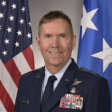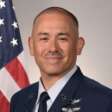Space Training and Readiness Command Goals
We already started to talk about bringing together the soft skills with what the Space Force needs for mission, and then walking that through whether you're a civilian coming off the street or coming in from another service, walking through the most basic training to the most advanced, how we see that across a career in delivering the right training at the right time for our guardians. In addition to training and education, maybe our most difficult technical challenge was the build out of a training and testing range. We called it the National Space Test and Training Complex.
Maj. Gen. Shawn Bratton
Commander, Space Training and Readiness Command, Space Force
When our guardians now go to basic training, now they have a specific identity. They're pushed by guardians and when they have questions about what they will be doing in the future, what it's like, they will get that directly right from a guardian. It was pretty significant.
Chief Master Sgt. James Seballes
Senior Enlisted Leader, Space Training and Readiness Command, Space Force
In the next few months, the Space Force will release a roadmap for the future of training.
This vision is the culmination of a year’s worth of work developing the concepts, skillsets and goals for the Space Training and Readiness Command (STARCOM).
Maj. Gen. Shawn Bratton, the commander of the Space Training and Readiness Command, said the roadmap will cover both tactical skills like running command and control technologies, and strategic skills to create the new culture at the Space Force.
“It really articulates where we are trying to get to as an end state. How do we think about intelligence and cyber operations, and space operations and training, and really the integration of those together? It comes back to that teamwork piece of I can’t just train an intelligence operator separate from a cyber operator separate from a space operator and acquirers and engineers. Really I need to train them to collect creatively.” Bratton said on the Modern Government: Space Training and Readiness Command show. “I think you’ll see us emphasize integration and training on what are opportunities to bring those communities together. And because the Space Force is so small, I think there’s a lot of opportunity to do things different in that way. Mainly, our scale allows us to do that. So we’re excited about it.”
The goal is to create a vision to educate the force as a new service, which launched in December 2019.
“We had a couple of very clear go dos from General [John] Raymond, [commander of Space Force], one of which was to establish an independent, professional military education for the Space Force by 2023,” Bratton said. “We already started to talk about bringing together the soft skills with what the Space Force needs for mission, and then walking that through whether you’re a civilian coming off the street or coming in from another service, walking through the most basic training to the most advanced, how we see that across a career in delivering the right training at the right time for our guardians. In addition to training and education, maybe our most difficult technical challenge was the build out of a training and testing range. We called it the National Space Test and Training Complex.”
Understanding their impact
The test range promotes both access to technology and the need to build collaboration among guardians.
Space Force plans to grow to about 18,000 personnel over the next few years so creating the best training approach becomes more important.
Chief Master Sergeant James Seballes, the senior enlisted leader for Space Force’s Training and Readiness Command, said another big challenge for the Space Force is creating an environment where guardians and civilians can understand the impact of their decisions and where leaders can analyze their performance.
“You understand the mission a little better when you actually get to go do something, which is what the range is meant to do by providing that albeit virtually, but to give them that live experience of what it’s like to actually do their mission and try to work through failure and challenges and lessons learned and get after those things, so that they can be prepared and ready to go should and when if that time comes,” Seballes said.
Another way the Space Force is creating its culture is through a recent basic training boot camp at Joint Base-San Antonio-Lackland that was the first for guardians only. Prior training sessions had been integrated with the Air Force.
“When our guardians now go to basic training, now they have a specific identity. They’re pushed by guardians and when they have questions about what they will be doing in the future, what it’s like, they will get that directly right from a guardian. It was pretty significant,” Seballes said. “The curriculum wasn’t completely revamped, but it was significantly changed. We added about 35 hours of Space Force specific curriculum that got after the different things that we prioritize in the Space Force like our core values, a better understanding of which each of the different specialties bring to the fight, to include them even getting a threat brief from operational folks here at STARCOM.”
More directed basic training
The second iteration of basic training is happening now and the training and readiness command will use feedback from the first two cohorts to continue to improve their approach. The Space Force only expects to recruit about 500 new guardian each year versus the Army, for instance, which seeks to bring in 120,000 new soldiers annually. Seballes said this gives the Space Force the ability to be more agile in its training curriculum.
Bratton added the Space Force only basic training is creating that identity and feeling of belonging to create a strong connection to the force.
“Even if they make a choice to leave the service and go out to industry, we still want them to know they’re still a guardian and still part of the team,” he said. “So how we make that connection, only time will tell if we’re successful, but basic training is absolutely one place where we’re just trying to set that right off the start that good found strong foundation.”
Advanced courses under development
Now that the Space Force has created that solid training foundation, Bratton said the plan to shift to more advanced training around concepts like electronic warfare through their “skies series.”
“Black Skies is an electronic warfare exercise where some of that will be what we call live fire. We use actual systems and operators, but to really put them through their paces and in more advanced training environment,” Bratton said. “We owe that to our cyber operators. Intelligence is incorporated in all of these exercises, but really bringing the team together not in the in the fundamentals, but upping our game a little bit and presenting them with a more difficult challenge. We’ll do that through the sky series next year, and then we’ll follow with the others in subsequent years.”
Seballes added the Space Force also is looking at how best to offer advanced degrees for the enlisted force to continue their professional development as both a way to retain guardians as well as a way to improve their skillsets.
“Going into year two, the plan is obviously to look at some other opportunities to either partner with institutions and continue with that toolbox, if you will, of professional development opportunities are another thing that that we’re moving toward,” he said. “We still rely pretty heavily on the Air Force for a lot of things, and we will into perpetuity. One of the areas in training is the tech schools where we own the school houses now and are starting to get our feet under what that means.”
Listen to the full show:
Copyright
© 2024 Federal News Network. All rights reserved. This website is not intended for users located within the European Economic Area.






